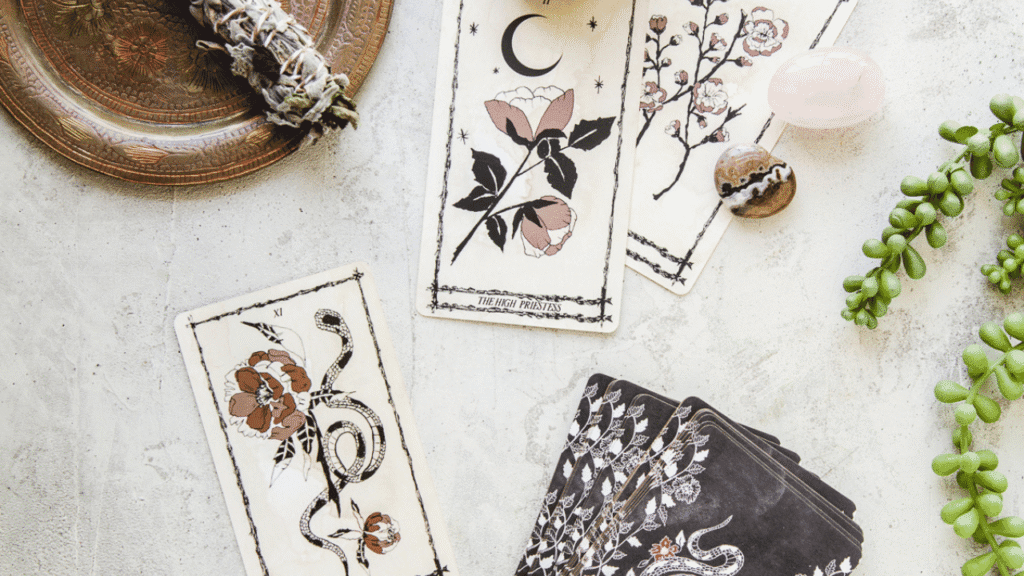Easy Guide How to Read Tarot Cards for Beginners

How to Read Tarot Cards? Tarot offers a powerful way to explore self-discovery and personal growth. With sales hitting a 50-year high, more people are turning to this ancient practice for guidance and inspiration. Whether you’re drawn to its spiritual aspects or therapeutic benefits, tarot is a tool that adapts to your journey.
Expert Mariana Louis reminds us that learning tarot is a journey, not a quick weekend project. It takes patience and trust in your intuition. Shannon Knight highlights its secular benefits, calling it a key to unlocking your best self.
This guide covers the essentials: choosing the right deck, understanding card meanings, and avoiding common mistakes. Start with a simple spread, like the Four-Card Check-In, and keep a journal to track your progress.
Key Takeaways
- How to Read Tarot Cards? Tarot is a versatile tool for self-reflection and guidance.
- Patience and intuition are crucial in learning.
- Select a deck that resonates with you personally.
- Simple spreads help build confidence.
- Journaling enhances your practice over time.
What Is Tarot and Why Should You Learn?
Originally a 15th-century Italian pastime, tarot transformed into a mirror for the soul. The game Tarocchini entertained nobles before Antoine Court de Gébelin reimagined it as a tool for divination in the 1700s. Today, its 78-card deck—split into Major and Minor Arcana—offers universal themes that resonate across cultures.
“The cards reflect timeless human struggles and triumphs.”
This duality makes tarot versatile—equally valuable for spiritual seekers and those exploring psychology. Meg Jones Wall, once skeptical, shares how a single reading clarified a career crossroads, proving its power beyond superstition.
Modern practitioners like Shannon Knight use tarot for self-reflection. The imagery nudges you to trust your intuition, whether interpreting the fiery Wands or introspective Cups. Studies suggest such symbolic thinking enhances decision-making and emotional clarity.
Why learn? Tarot isn’t about predicting the future—it’s a map for navigating life’s twists. The Major Arcana’s archetypes (like The Fool or The Tower) frame big transitions, while the Minor Arcana’s suits mirror daily challenges. It’s guidance, not prophecy, wrapped in 600 years of wisdom.
How to Read Tarot Cards

Your first deck sets the tone for your entire journey—choose wisely. Forget the myth that it must be gifted. “Your connection matters more than tradition,” says reader Francisco Sanchez. Whether you’re drawn to classic symbolism or modern art, your deck should feel like a natural extension of your intuition.
Popular Decks for Beginners
The Rider-Waite deck (1909) remains a top pick for its clear imagery. Its scenes—like The Fool’s cliffside step—tell stories at a glance. Modern alternatives offer fresh twists:
- Modern Witch Tarot: Bold, inclusive artwork.
- Ethereal Visions: Gold-inked, dreamy illustrations.
- Mystic Mondays: Vibrant colors for intuitive pulls.
Shannon Knight recommends visiting local metaphysical shops. “Holding a deck tests its feel—card thickness, shuffle ease,” she notes. Online? Etsy and indie creators offer unique designs.
Trusting Your Intuition
Color schemes and art styles shape your readings. Knight prefers sepia tones for their grounded energy, while others thrive with neon hues. If a deck’s imagery sparks joy, it’s likely the right fit.
Deck maintenance keeps energy clear:
- Cleanse with sage or moonlight.
- Store wrapped in silk to protect vibes.
- Journal first pulls to track connections.
Budget-wise, $20–$50 covers most starter decks. Guidebooks add value, but free online resources like Little Red Tarot help too. Remember: Your deck should whisper to you—not follow trends.
Understanding the Structure of a Tarot Deck

Every tarot deck holds a hidden language of symbols waiting to be unlocked. Its 78 cards split into two pillars: the Major Arcana and Minor Arcana. Together, they reflect life’s grand narratives and everyday moments.
Major Arcana: The Big Life Themes
The 22-card Major Arcana sequence—from The Fool (0) to The World (21)—tells a universal story. Each card represents archetypes like love (The Lovers) or transformation (Death). “These aren’t predictions but mirrors,” explains Meg Jones Wall. “They frame our growth phases.”
Antoine Court de Gébelin’s 18th-century interpretations shaped their meaning. Even “scary” cards like The Devil symbolize bondage to unhealthy patterns, not literal evil. Wall’s keyword cheat sheet simplifies their messages:
- The Fool: New beginnings, trust
- The Tower: Sudden change, revelation
- The Star: Hope, inspiration
Minor Arcana: The Four Suits
The Minor Arcana’s 56 cards dive into daily life through four elemental suits. Each aligns with an energy:
- Wands (Fire): Passion, creativity
- Swords (Air): Intellect, conflict
- Cups (Water): Emotions, relationships
- Pentacles (Earth): Finances, stability
“Notice how the imagery speaks to you,” suggests Francisco Sanchez. A flaming Wand or a watery Cup can clarify a card’s message faster than memorizing definitions.
How to Read Tarot Cards Basic Techniques

Mastering tarot begins with grounding yourself in simple yet powerful techniques. Whether you’re pulling a single card or exploring spreads, these methods build confidence in your practice.
Meg Jones Wall’s journal method helps track patterns. Note each pull’s imagery, emotions, and real-life connections. Over time, this reveals how your deck communicates uniquely with you.
Cleansing and Grounding
Francisco Sanchez’s sage ritual prepares your space:
- Light dried sage and circle the deck clockwise.
- Set an intention aloud (e.g., “Clarity for today’s reading”).
- Fan the cards to disperse stagnant energy.
Mariana Louis pairs this with sunset meditation. Breathe deeply while visualizing golden light wrapping each card. This calms the mind for sharper intuition.
Interpreting the Cards
Shannon Knight’s mirror analogy changes everything: “The images reflect your subconscious, not fixed meanings.” Try these approaches:
- Traditional: Study guidebook symbolism.
- Intuitive: Note immediate feelings or memories.
“Avoid emotional spiraling by framing tough cards as growth prompts.”
Ethics matter too. Use readings for self-awareness, not decisions for others. For deeper guidance, explore trusting your intuition over rigid rules.
Consistent practice—even five minutes daily—strengthens your bond with the cards. Keep sessions light, and let curiosity lead.
Simple Tarot Spreads to Try Today
Discover the magic of uncomplicated layouts for daily guidance. These beginner-friendly techniques help build confidence while revealing powerful insights. Start small, trust your intuition, and let the cards speak.
The Daily One-Card Pull
This minimalist spread offers clarity for your day. Pull one card each morning and ask: “What energy should I work with today?” Shannon Knight suggests keeping a journal to track patterns over time.
Try Biddy Tarot’s picture-based method:
- Note colors and symbols that stand out
- Write your first emotional reaction
- Relate it to upcoming events
The author discovered recurring Cups suit cards during stressful weeks—a gentle nudge to prioritize self-care. Moon phases can deepen interpretations; new moons often signal fresh starts.
The Four-Card Check-In
This therapeutic spread examines different life areas. Position meanings:
- Physical: Body awareness or health
- Mental: Thoughts or challenges
- Spiritual: Inner growth
- Emotional: Current feelings
“I pulled The Tower for ‘mental’ during a career crisis—it perfectly captured my shaken confidence before a breakthrough.”
For financial clarity, one reader drew the Five of Pentacles (fear), reversed (release). This mirrored their anxiety about investing—and the need to trust their future security.
Morning readings often feel more actionable, while evening pulls help process the day’s events. Let your experience guide the timing that works best.
Building a Relationship with Your Tarot Deck

A strong bond with your deck transforms readings from mechanical to meaningful. Like a trusted friend, it reflects your growth over time. Meg Jones Wall’s chronological journaling system helps track this evolution—note card pulls alongside life events to spot patterns.
Mariana Louis swears by her card-a-day practice. Each morning, she studies one card’s imagery, then revisits it at night. “The Three of Swords felt harsh until I linked it to a tough conversation I’d avoided,” she shares. This builds familiarity without overwhelm.
Try Shannon Knight’s “deck interview” spread to break the ice. Pull three cards asking:
- What’s your personality?
- What can you teach me?
- How should we work together?
“My first deck threw The Star—it wanted to focus on hope, not doom-scrolling.”
Knight’s “emo kid” phase shaped her approach. She doodled on her deck’s box, creating a visual bond. Seasonal rotations—lighter art in spring, darker in winter—keep the connection fresh.
Charge your cards under a full moon to amplify their energy. Place them on a windowsill with a clear quartz crystal. This ritual, paired with monthly self-reflection readings, layers wisdom into your journey.
Common Tarot Mistakes to Avoid

Even seasoned practitioners sometimes stumble when interpreting the cards. Recognizing these pitfalls early saves frustration and deepens your connection to the practice. Below are five errors to sidestep—and expert-backed fixes.
Meg Jones Wall warns against treating guidebooks as gospel. “The imagery should spark your intuition, not replace it,” she says. Francisco Sanchez suggests noting three personal meanings per card to build flexibility.
2. Forced positivity
Mariana Louis encourages open-ended questions like “What do I need to see?” instead of seeking only good news. Shadow cards (e.g., The Devil) often reveal growth opportunities.
- Stalker cards: Repeating cards signal unresolved themes, not bad luck.
- Crisis readings: Avoid pulls during emotional spirals—try journaling first.
“Tarot isn’t a crystal ball. It’s a mirror for your subconscious.”
3. Cultural appropriation in rituals
White sage isn’t mandatory for cleansing. Alternatives like sound baths or lavender respect Indigenous traditions while refreshing your deck’s energy.
For deeper guidance on avoiding common pitfalls, explore nuanced approaches to card interpretation. Remember: every “mistake” is a step toward mastery.
Conclusion
How to Read Tarot Cards? Modern self-care tools blend ancient wisdom with personal reflection. Start small—try a daily one-card pull or the Four-Card Check-In. Let your intuition guide interpretations, not rigid definitions.
Apps like Co-Star merge astrology with digital guidance, showing tarot’s evolving role. Whether used for meditation or decision-making, it’s a practice that grows with you.
Meg Jones Wall sums it up: “It’s about empowerment, not predicting the future.” Your tarot journey is unique. Trust the process, and let the cards light your way.












